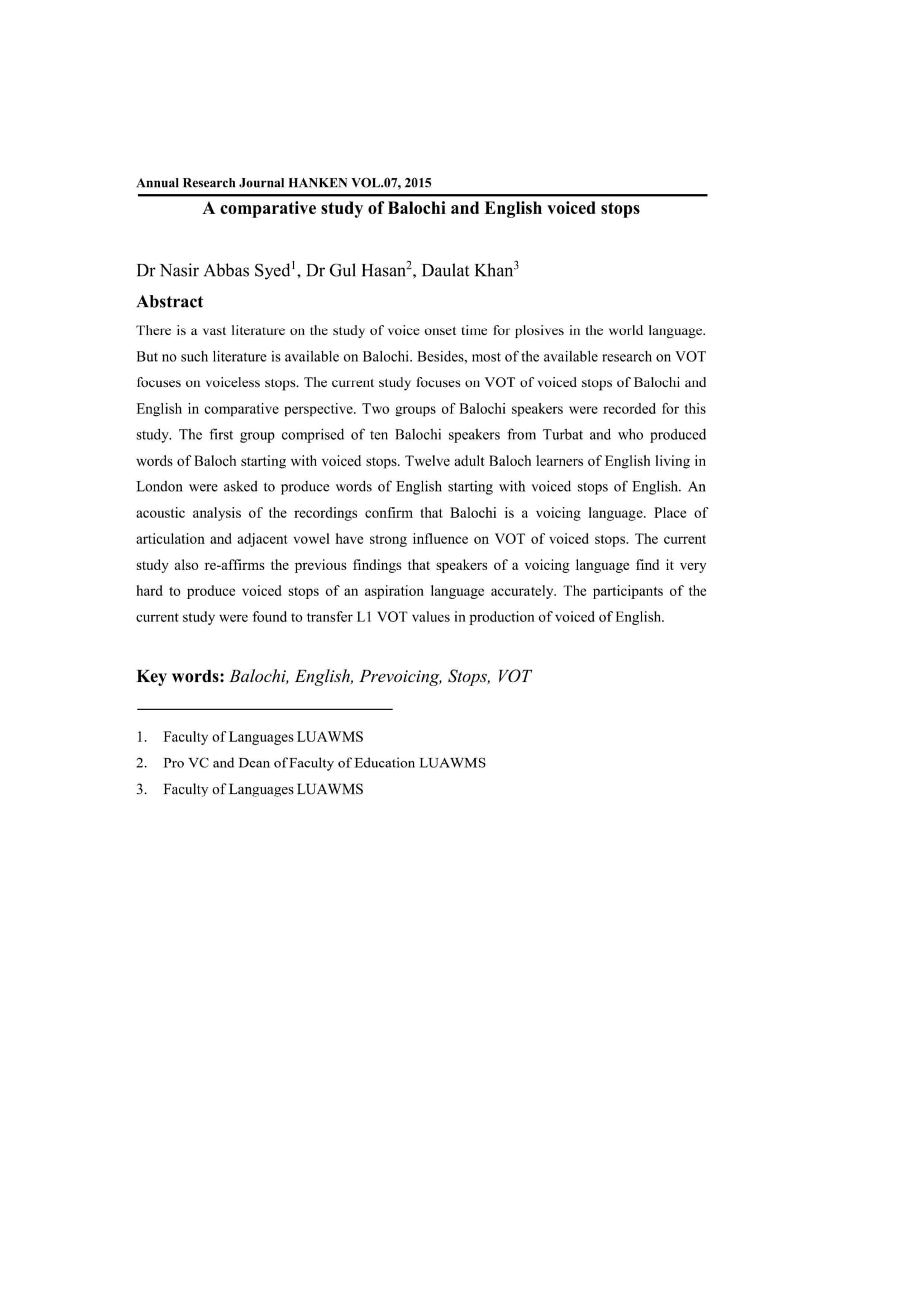A comparative study of Balochi and English voiced stops
Keywords:
Balochi, English, Prevoicing, Stops, VOTAbstract
There is a vast literature on the study of voice onset time for plosives in the world language. But no such literature is available on Balochi. Besides, most of the available research on VOT focuses on voiceless stops. The current study focuses on VOT of voiced stops of Balochi and English in comparative perspective. Two groups of Balochi speakers were recorded for this study. The first group comprised of ten Balochi speakers from Turbat and who produced words of Baloch starting with voiced stops. Twelve adult Baloch learners of English living in London were asked to produce words of English starting with voiced stops of English. An acoustic analysis of the recordings confirm that Balochi is a voicing language. Place of articulation and adjacent vowel have strong influence on VOT of voiced stops. The current study also re-affirms the previous findings that speakers of a voicing language find it very hard to produce voiced stops of an aspiration language accurately. The participants of the current study were found to transfer L1 VOT values in production of voiced of English.
References
Boersma, Paul, & Weenink, David. (2012). Praat: doing phonetics by computer.
Davenport, M., & Hannahs, S. J. (2010). Introducing Phonetics and Phonology (3 ed.). London: Hodder Education.
Docherty, G.J. (1992). The timing of voicing in British English obstruents. Berlin: Foris publications.
Flege, James Emile. (1995). Second language speech learning: Theory, findings, and problems. In W. Strange (Ed.), Speech perception and linguistic experience: Issues in cross-language research (pp. 233-277). New York: Timonium, MD.
Flege, James Emile, & Port, Robert. (1981). Cross-language phonetic interference: Arabic to English. Language & Speech, 24(2), 125-146.
Foulkes, P., Docherty, G., & Jones, M. J. (2010). Analyzing Stop. In F. P, D. G. J & J. M. J (Eds.), Sociophonetics: a student’s guide (pp. 58-71). London: Routledge.
Harris, John. (1994). English sound structure. Oxford: Blackwell.
Honeybone, P. (2005). Diachronic evidence in segmental phonology: The case of laryngeal specifications. Berlin: Mouton de Gruyter.
Iverson, Gregory K., & Salmons, Joseph C. (1995). Aspiration and laryngeal representation in Germanic. Phonology, 12(3), 369-396.
Ladefoged, Peter. (2006). A course in phonetics (Vol. 5). Boston, MA: Thomson Wadsworth.
Ladefoged, Peter, & Maddieson, Ian. (1996). The sounds of the world's languages. Oxford: Blackwell.
Larson-Hall, J. (2010). A guide to doing statistics in second language research using SPSS. New York: Routledge.
Lisker, L., & Abramson, A. (1964). A cross-language study of voicing in initial stops: acoustical measurements. Word, 20(3), 384-422.
Lisker, L., & Abramson, A. (1967). Some effects of context on voice onset time in English stops. Language and Speech, 10, 1-28.
Nasukawa, K. (2010). Place-Dependent VOT in L2 Acquisition. In M. T. P. e. al (Ed.), Selected Proceedings of the 2008 Second Language Research Forum (pp. 198-210). Somerville: Cascadilla Proceedings Project.
Roca, I., & Johnson, Wyn. (2007). A course in phonology. Oxford: Blackwell.
Scholfield, Phil. (1995). Quantifying language: A researcher's and teacher's guide to gathering language data and reducing it to figures. Clevendon/Philadelphia: Multilingual Matters Ltd.
Shimizu, K. (2011). Study on VOT of initial stops in English produced by Korean, Thai and Chinese speakers as L2 learners. Paper presented at the. ICPhS XVII, Hong Kong.
Simon, E. (2009). Acquiring a new second language contrast: an analysis of the English laryngeal system of first language Dutch speakers. Second Language Research, 25(3), 377-408.
Simon, E. (2011). Laryngeal stop systems in contact: Connecting present-day acquisition findings and historical contact hypotheses. Diachronica, 28(2), 225-254.
Stevens, K.N., Keyser, S.J., & Kawasaki, H. . (1986). Toward a Phonetic and Phonological Theory of Redundant Features. In J. S. Perkell & D. H. Klatt (Eds.), Invariance and variability in speech processes (pp. 426-463). New Jersey: Lawrence Earlbaum Associates.
Syed, Nasir A. (2011). Perception and production of consonants of English by Pashto speakers. The Journal of Humanities and Social Sciences, XIX(1), 119-146.
Syed, Nasir A. (2013a). Acquisition of a new sound without separate category formation. In B. Surany (Ed.), Proceedings of the Second Central European Conference in Linguistics for Postgraduate Students (pp. 230-245). Pilicscaba, Budapest: Peter Pazmany Catholic University Hungary.
Syed, Nasir A. (2013b). Voice onset time for plosives in Saraiki: Implications for the acquisition of English aspiration contrast. EFL Annual Research Journal 2012 Shah Abdul Latif University Khairpur, 14, 1-15.
Syed, Nasir A. (2014). Why Pakistani learners cannot acquire voiced stops of English? Journal of Research and Social Sciences, 1(1), 19-30.
Syed, Nasir A. (2015). Pak-Indian English: A common legacy of British colonialism. Paper presented at the First International conference of Linguistic Association of Pakistan (LAP), Kinnaird College for Women University Lahore.
Syed, Nasir A., & Hasan, Gul. (2015). An-acoustic analysis of speech of London-based Baloch learners of English. Balochi Review, XXXI(2), 91-104.


